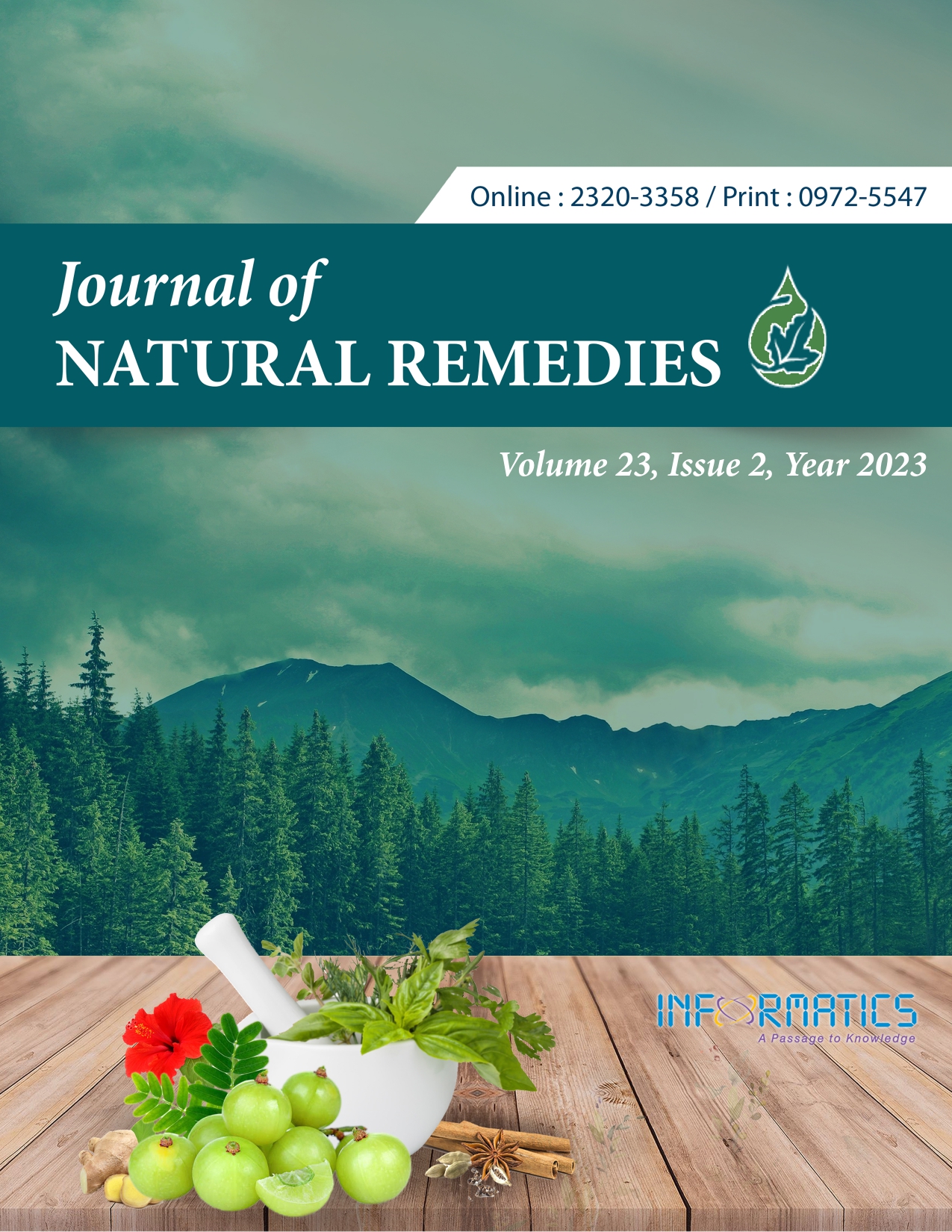Physicochemical Characterization and Cytocompatibility Study of Lyophilized Cow Urine Powder
DOI:
https://doi.org/10.18311/jnr/2023/31414Keywords:
Analytical Techniques, Fibroblast Cells, Indian Breed, SahiwalAbstract
Cow urine is known for possessing therapeutic potency which is found to vary depending upon its physical forms such as fresh sterile urine, distillate, lyophilized powder, etc. In the current work, we demonstrate the physicochemical characteristics and cytocompatibility of lyophilized powder of cow urine obtained from Sahiwal and the pure Indian breed. We have used several analytical techniques, including Thermogravimetric Analysis (TGA), Fourier Transform Infrared (FTIR) Spectroscopy, Differential Scanning Calorimetry (DSC), Nuclear Magnetic Resonance (NMR) spectroscopy and Scanning Electron Microscopy – Energy Dispersive X-ray Spectroscopy (SEM-EDX) to examine the physical and chemical nature of cow urine powder obtained through lyophilization. SEM-EDX analysis showed clusters like morphology and revealed 25-30% of metal ions present in both samples. TGA analysis showed three steps of degradation sequentially most likely due to initial desorption of adsorbed water, urea degradation, and loss of glycoside moiety present in flavonoid. DSC data revealed the presence of both irregular (amorphous) and ordered molecular structures (crystalline) in the lyophilized powder of cow urine. <sup>1</sup>H NMR spectra of all the prepared cow urine samples exhibited a similar trend and did not vary significantly and; confirming the presence of the same flavonoid/compounds in each sample. FTIR spectra of all the prepared cow urine samples exhibited a similar trend and did not vary significantly as observed through <sup>1</sup>H NMR spectra. In addition, a cytocompatibility study and MTT assay using NIH-3T3 fibroblast cells revealed that lyophilized cow urine powders possessed no deleterious effects on healthy fibroblast cells. Thus, the outcomes provide a benchmark for further understanding of the lyophilized form of cow urine that could be potentially useful for analyzing its therapeutic value.
Downloads
Metrics
Downloads
Published
How to Cite
Issue
Section
License
Copyright (c) 2023 Pallawi, Neeraj K. Vishwakarma, Sushmitha Paulraj, Sanjeev Kumar Mahto, Kameshwarnath Singh (Author)

This work is licensed under a Creative Commons Attribution 4.0 International License.
Accepted 2023-04-28
Published 2023-06-13
References
Brown WN. The Sanctity of the Cow in Hinduism. 1964; 12.
Mohanty I, Senapati M, Jena D, Palai S. Diversified uses of cow urine. 2014. Available from: https://www. semanticscholar.org/paper/DIVERSIFIED-USES-OFCOW- URINE-Mohanty-Senapati/158dd34680ce8670c3a6 2efad4f27623889ac49b
Joshi RD, Adhikari N. Benefits of cow urine, milk, ghee, curd, and dung versus cow meat. Act Scie Pharma. 2019; 3:169-75. https://doi.org/10.31080/ASPS.2019.03.0360 DOI: https://doi.org/10.31080/ASPS.2019.03.0360
Adhikari N, Joshi DR. Cow urine: The Total research on cow urine from the very beginning to till date. 2020. https://doi.org/10.13140/RG.2.2.24063.23204
Dhama K, Chauhan R, LK, S. Anti-cancer activity of cow urine: current status and future directions. International Journal of Cow Sciences. 2005; 1:1-25.
Rekha S, Rakshapal G, OmPrakash R. Benefits of cow urine – A review. 3.
Gulhane H, Nakanekar A, Mahakal N, Bhople S, Salunke A. Gomutra (cow urine): A multidimensional drug review article. Int J Res Ayurveda Pharm. 2017; 8:1-6. https://doi.org/10.7897/2277-4343.085231 DOI: https://doi.org/10.7897/2277-4343.085231
Pradhan SS, Verma S, Kumari S, Singh Y. Bio-efficacy of cow urine on crop production: A review. International Journal of Chemical Studies. 2018; 5.
Jandaik S, Thakur P, Kumar V. Efficacy of cow urine as plant growth enhancer and antifungal agent. Advances in Agriculture. 2015; 1-7. https://doi.org/10.1155/2015/620368 DOI: https://doi.org/10.1155/2015/620368
Sahu R, Krishnaiah N, Ramya P, Anusha P. Cow urine- Therapeutic value. Int J Livest Res. 2016; 6:93. https://doi. org/10.5455/ijlr.20160930083917 DOI: https://doi.org/10.5455/ijlr.20160930083917
Gosavi D, Sachdev D, Salwe K. Evaluation of antidiabetic, antioxidant effect and safety profile of gomutra ark in Wistar albino rats. Ancient Sci Life. 2012; 31:84. https://doi.org/10.4103/0257-7941.103180 DOI: https://doi.org/10.4103/0257-7941.103180
Jarald EE. Edwin S, Tiwari V, Garg R, Toppo E. Antidiabetic activity of cow urine and a herbal preparation prepared using cow urine. Pharmaceutical Biology. 2008; 46:789-792. https://doi.org/10.1080/13880200802315816 DOI: https://doi.org/10.1080/13880200802315816
Dhama K, Rathore R, Chauhan R, Tomar S. n.d. Panchgavya (cowpathy): An overview. 2005; 16.
Randhawa GK, Sharma R. Chemotherapeutic potential of cow urine: A Review. 2015; 4:7. https://doi.org/10.5455/jice.20150222100320 DOI: https://doi.org/10.5455/jice.20150222100320
Hirapara H, Ghori V, Anovadiya A, Tripathi C. Evaluation of wound healing activity of cow urine ark in diabetic Wistar albino rats. J Intercult Ethnopharmacol. 2016; 5:434. https://doi.org/10.5455/jice.20160923100135 DOI: https://doi.org/10.5455/jice.20160923100135
Sanganal J, Jayakumar KJ, Gm J, Tikare V, RP. Effect of cow urine on wound healing property in Wister Albino Rats Vet World. 2011; 317. https://doi.org/10.5455/vetworld.4.317 DOI: https://doi.org/10.5455/vetworld.4.317
Jarald E, Edwin S, Tiwari V, Garg R, Toppo E. Antioxidant and antimicrobial activities of cow urine. 2008; 4.
Varshney N, Sahi AK, Poddar S, Mahto SK. Soy protein isolate supplemented silk fibroin nanofibers for skin tissue regeneration: Fabrication and characterization. Int J Biol Macromol. 2020; 160:112-127. https://doi.org/10.1016/j.ijbiomac.2020.05.090 DOI: https://doi.org/10.1016/j.ijbiomac.2020.05.090
Wang M, Li J, Rangarajan M, Shao Y, LaVoie EJ, Huang T-C, Ho C-T. Antioxidative phenolic compounds from sage (Salvia officinalis). J Agric Food Chem. 1998; 46:4869-4873. https://doi.org/10.1021/jf980614b DOI: https://doi.org/10.1021/jf980614b
Aruna R, Spadmapriya S. Evaluation of the antimicrobial activity of indigenous cow urine against bacterial fish pathogens. International Journal of Zoology Studies. 2016; 1:29-31.

 Pallawi
Pallawi









 0.35
0.35 24
24 0.161
0.161